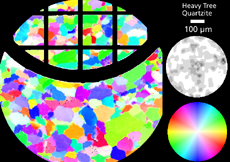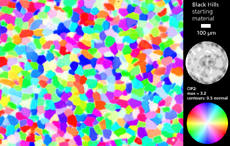4.1
ORIENTATION IMAGES OF EXPERIMENTALLY DEFORMED ROCKS
top / contents / section 4 / pages -- 4.1 -- 4.2 -- 4.3 -- 4.4 -- 4.5 -- 4.6 -- 4.7
Starting material: Black Hills quartzite and Heavitree quartzite

Heavitree quartzite: Non-porous quartzite, with ~1% impurities, and equant grains with average diameter ~200 µm. Diagenetic overgrowths visible.
Black Hills quartzite: Quartzite with up to 1% porosity and very few impurities. Equant grains have an average diameter of ~100 µm.
Here, the input images were taken with a rotating microscope stage and fixed polarizers and lambda plate (rather than fixed stage and rotating polarizers and lambda plate). This is why only a central portion of the image can be used. The Heavitree quartzite was one of the first c-axis orientation images (COIs) calculated for this type of input. For rematching purposes, a TEM holder was placed on the thin section. This, however proved to be unnecessary. Using NIH Image (or Scion Image) and the Lazy stack macro (see appendix 2), the input can be rematched easily.
Left, from top to bottom:
- Heavitree quartzite, undeformed, average grain diameter approx. 300 µm
- Black Hills quartzite, undeformed, average grain diameter approx. 100 µm
